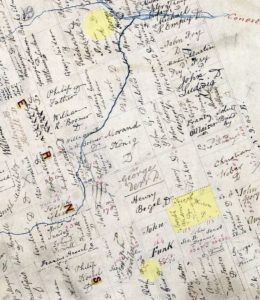 The family farm of Peter Joseph Voisin and Catherine (Meyer) Voisin is detailed in the 1871 census of Wellesley Township, Waterloo County, Ontario. They had 1 dwelling house and 1 barn. They owned 3 carriages or sleighs, 3 cars, wagons or sleds, 3 plows or cultivators, 1 reaper or mower, 1 horse rake, 1 thrashing machine and 1 fanning mill to winnow grain.
The family farm of Peter Joseph Voisin and Catherine (Meyer) Voisin is detailed in the 1871 census of Wellesley Township, Waterloo County, Ontario. They had 1 dwelling house and 1 barn. They owned 3 carriages or sleighs, 3 cars, wagons or sleds, 3 plows or cultivators, 1 reaper or mower, 1 horse rake, 1 thrashing machine and 1 fanning mill to winnow grain.
They owned 143 acres situated in Concession 8, Lot 1. Of that, 120 acres were improved, 14 acres were pasture, and 3 acres were gardens or orchards. They planted wheat on 30 acres and harvested 150 bushels of spring wheat and 250 bushels of fall wheat. They produced 400 bushels of oats, 100 bushels of peas, and 300 bushels of turnips. They had 5 acres devoted to potatoes and produced 100 bushels. They had 14 acres of hay that yielded 18 tons. They also produced 6 ½ bushels of grass or clover seed, 70 bushels of apples, 2 bushels of pears, plums or other fruit, 200 pounds of maple sugar, and 15 cords of fire wood.
In livestock, they had 4 horses, 2 colts or fillies, 8 milch (dairy) cows, 8 other horned cattle, 23 sheep, and 9 swine. They sold or slaughtered 1 cow and 5 swine. They produced 400 pounds of butter and 70 pounds of wool. They hand-made 50 yards of cloth or flannel and 12 yards of linen.
The map from 1844 shows the Voisin farm in the eastern section of Wellesley Township, Waterloo County, Ontario. This was before the villages of Hawkesville, highlighted upper center, and St. Clements, highlighted lower center, were even established.
